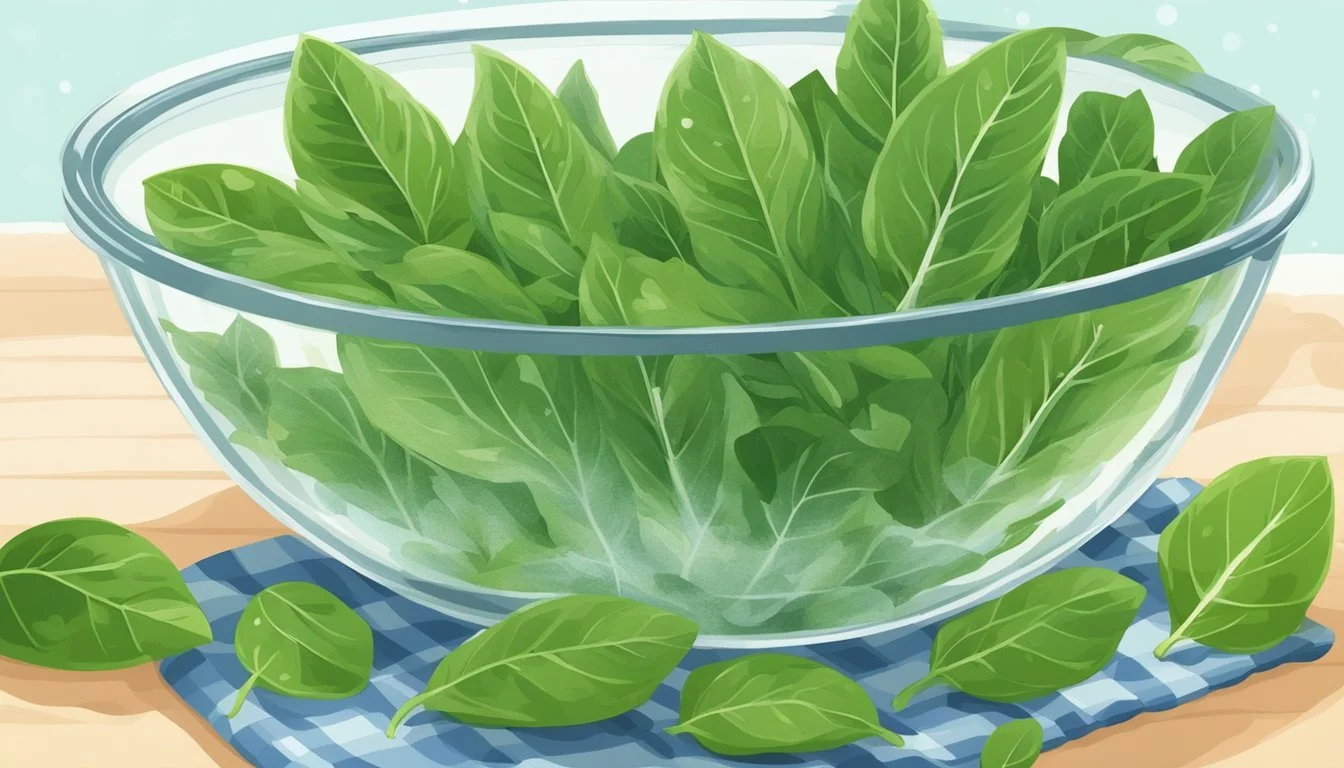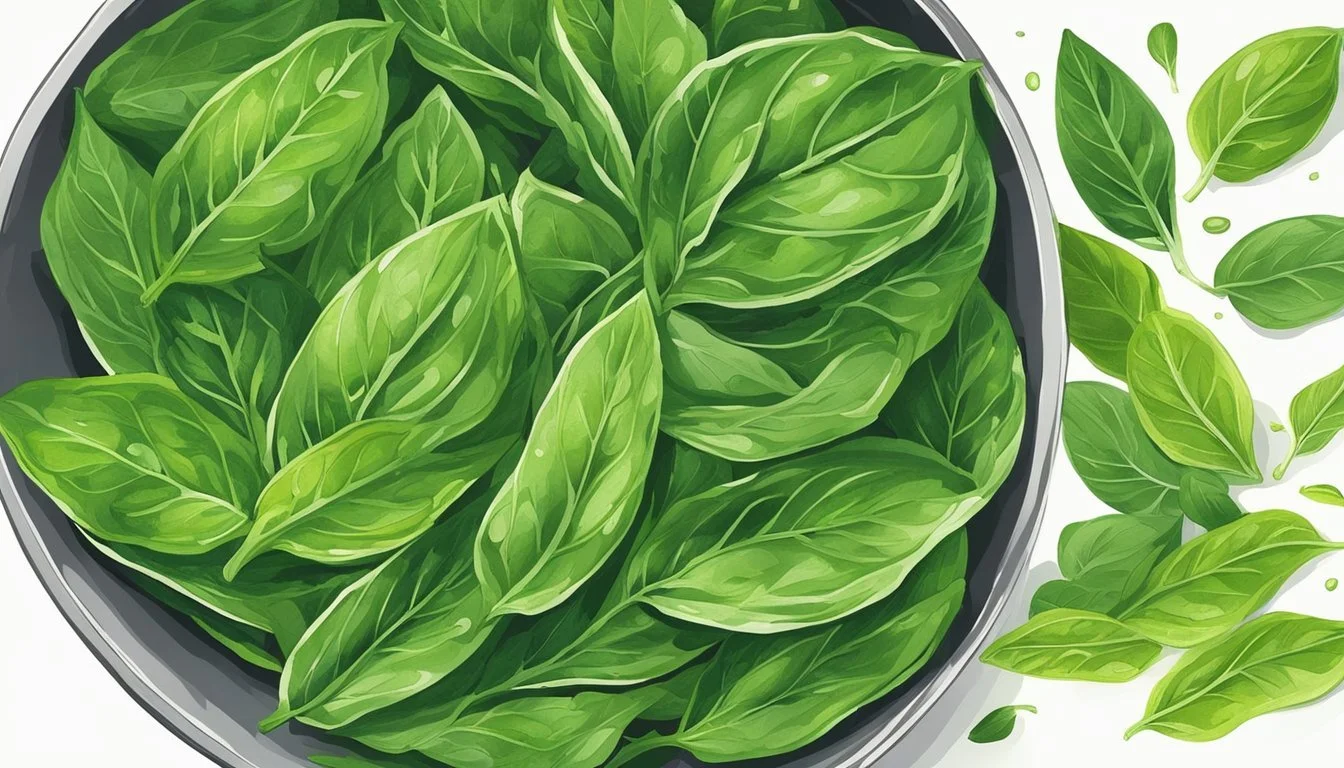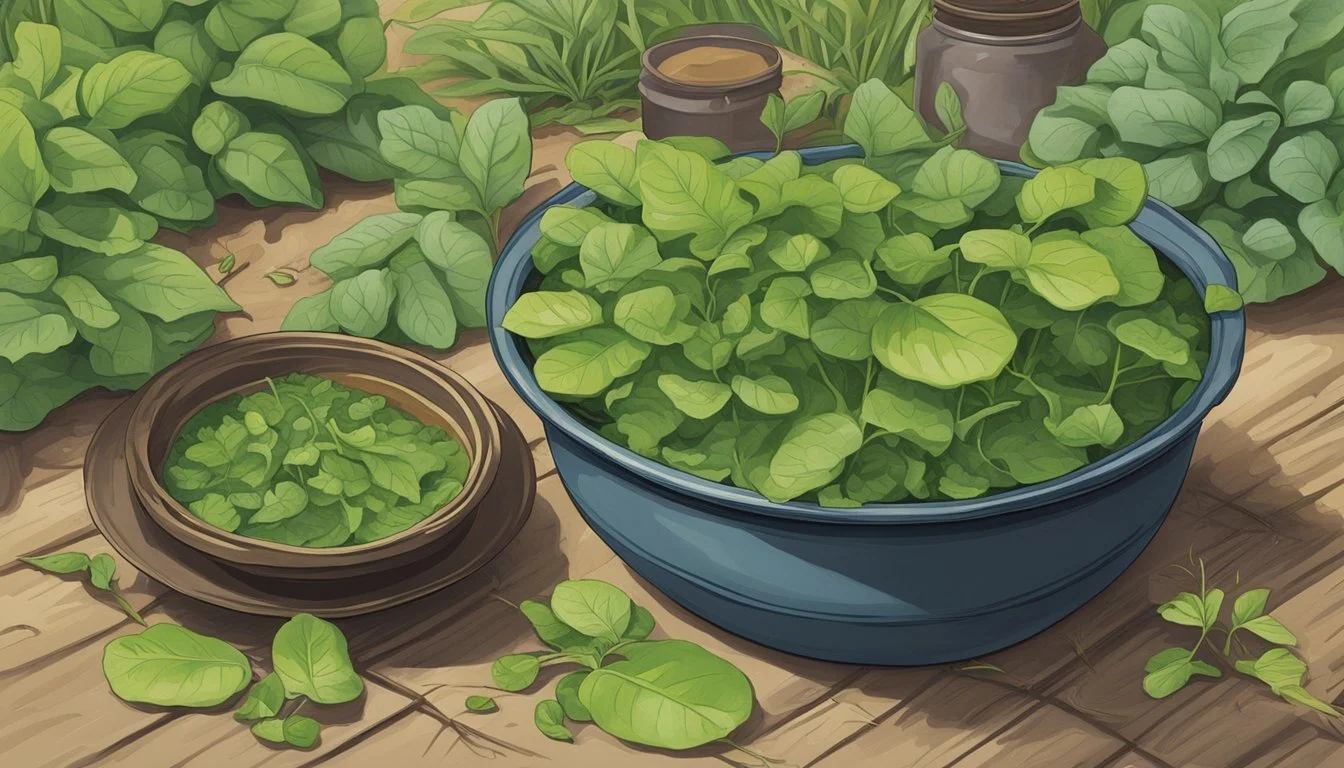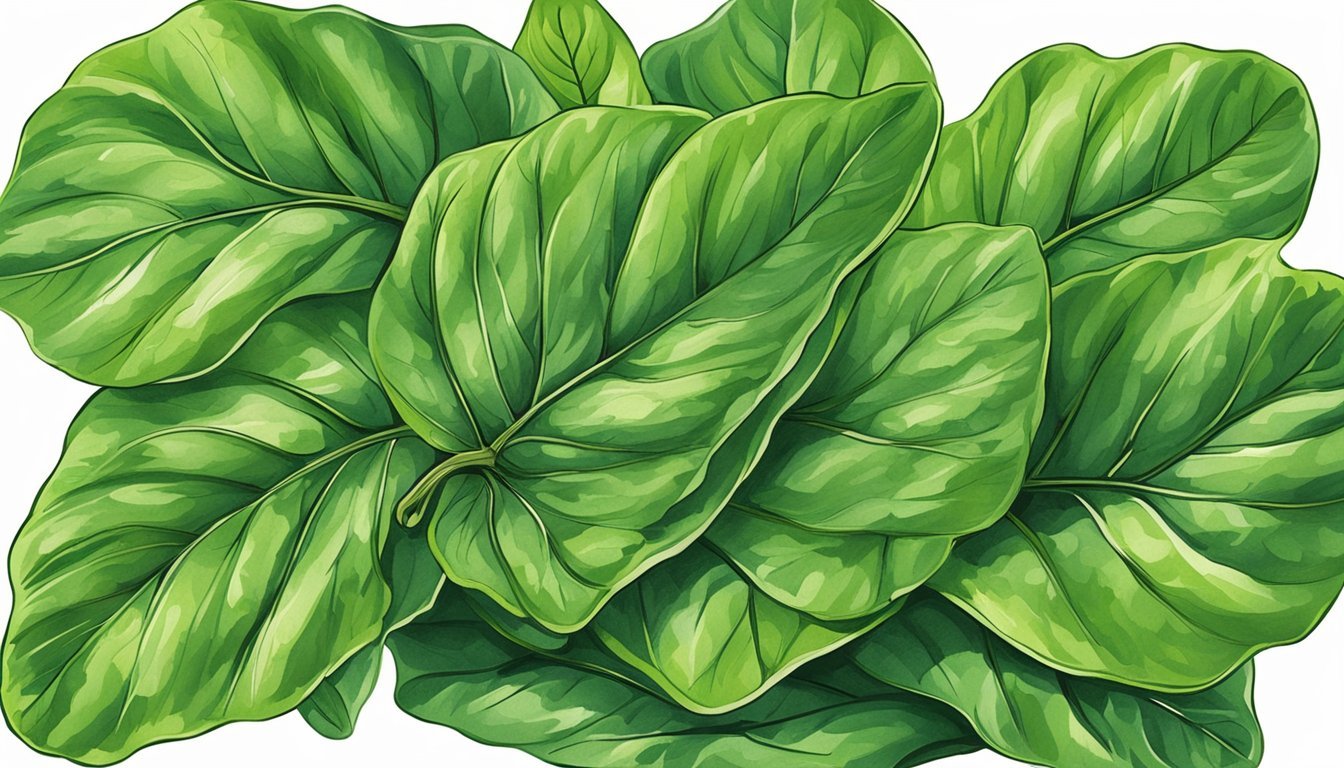Reviving Limp Sorrel
Tips for Restoring Freshness to Your Herbs
Sorrel is a leafy herb known for its tangy, lemony flavor, which adds a unique, bright taste to various dishes. This perennial herb is not only a popular garden plant but also an excellent addition to soups (What wine goes well with soups?), sauces, and salads. However, like many leafy greens, sorrel can sometimes become limp or wilted if not used fresh. Fortunately, there are methods to revive sorrel, ensuring that its crisp texture complements its distinctive taste in culinary uses.
To breathe new life into wilted sorrel, a simple technique involving cold water can be utilized. This process, akin to refreshing other herbs and vegetables, is both straightforward and effective. By submerging the limp leaves in cold water, the sorrel experiences a shock that helps restore its firmness. This is particularly useful for those who wish to use the herb to its full potential, as the crispness of the leaves is pivotal for both the texture and presentation of the final dish.
It's important to ensure that sorrel's refreshing qualities are preserved, as they play a vital role in the balance of flavors, especially in creamy soups and rich sauces. The sharp zest of sorrel contrasts with heavier ingredients, maintaining the dish's complexity. Reviving sorrel not only prevents food waste but also maintains the caliber of the recipes it graces, highlighting the importance of proper herb handling in the culinary arts.
Distinct Characteristics of Sorrel
Sorrel stands out in the herb world for its nutritious qualities and zesty flavor. This section delves into the key aspects of the sorrel plant, including cultivation, nutritional content, taste, and variety.
Growing and Harvesting Sorrel
Sorrel thrives in rich, well-draining soil, preferring a moderately acidic environment. It requires abundant sunlight but can tolerate partial shade. Harvesting typically involves plucking the leaves when they are young and tender, which ensures the best flavor and texture.
Nutritional Properties: Vitamin C and Iron
Sorrel is a nutrient powerhouse, rich in vitamin C, an antioxidant essential for immune health. Additionally, it contains iron, vital for oxygen transport in the blood. However, it's important to note that it also contains oxalic acid, which in high quantities can affect nutrient absorption.
Nutrient Benefit Vitamin C Supports the immune system and skin health Iron Essential for blood production Oxalic Acid Can interfere with nutrient absorption
Sorrel's Flavor Profile: Tangy and Citrusy
The leaves of sorrel are known for their tangy and citrusy taste, reminiscent of lemons, which makes them a perfect addition to soups and sauces. This distinctive flavor is due to the presence of oxalic acid, which imparts a sharp, refreshing quality.
Sorrel Varieties: Garden Sorrel and French Sorrel
When considering sorrel varieties:
Garden Sorrel (Rumex acetosa): Known for its large, arrow-shaped leaves and robust flavor.
French Sorrel (Rumex scutatus): Features smaller, rounded leaves with a milder, more subtle citrus profile.
Both varieties contribute a lemony zing to dishes, but the garden type is more potent, whereas the French variety is valued for its delicate nuance.
Incorporating Sorrel into Cooking
Sorrel is a green, leafy herb that brings a lemony tang to a variety of dishes, enhancing flavors especially in soups and sauces. Its acidic, slightly sour taste is a key component in culinary traditions and becomes a fresh companion for proteins.
Sorrel as a Herb in Culinary Traditions
Historically, sorrel has been a herb treasured in various culinary traditions for its bright, citrus-like flavor, perfect for adding a fresh note to dishes. In French cuisine, it's often pureed and utilized in Sorrel Soup, lending its characteristically sharp taste. With a texture similar to spinach (What wine goes well with spinach?) when cooked, sorrel can easily be integrated into dishes as a complementary green.
Uses in Cooking:
Fresh: Salad mixes or garnishes for a zesty bite.
Cooked: Blended into soups, sauces, or stews for a tangy infusion.
Pesto: Sorrel leaves can be used in place of basil for a lemony twist on the classic sauce.
Pairing Sorrel with Proteins
When it comes to pairing sorrel with proteins, its vibrant tartness cuts through the richness of various meats and complements delicate seafood beautifully. The herb works wonders when paired with:
Fish: The lemony notes of sorrel make it an ideal match for the mild flavors of fish. It can be used in sauces drizzled over grilled or steamed fish or even incorporated into a marinade.
Chicken: Enhance roasted or pan-fried chicken with a sorrel sauce or chop fresh sorrel to include in a stuffing for added zest.
Eggs: Sorrel can elevate a simple egg dish, with its acidity balancing the richness of the yolks. Try chopping it into an omelette or over a poached egg for a vibrant breakfast twist.
By considering the natural acidity of sorrel, chefs and home cooks alike can introduce a unique twist to their protein dishes, achieving a harmonious balance of flavors.
The Art of Perfect Sorrel Soups
In crafting the perfect sorrel soup, one must understand the delicate balance of its tangy flavor and velvety texture, achieved through proper cooking techniques and ingredient combinations.
Traditional Sorrel Soup Recipes
Traditional sorrel soup recipes often begin with a base of broth, typically chicken or vegetable, to provide depth and richness. A foundation of finely chopped onions sautéed in butter until translucent is common, as seen in Brenda Gantt's approach. The essence of the soup lies in its namesake ingredient, sorrel leaves, which should be thoroughly washed before being added to the pot. Here is a simple list to break down the core components:
Broth: Chicken or vegetable for a flavorful base.
Sorrel: Fresh leaves, wilted and blending their lemony essence into the broth.
Onion: Adds a subtle sweetness once sautéed.
Potato: Often included as a thickening agent, diced or pureed to enhance the texture.
Cream: Stirred in after cooking for a smooth and creamy finish.
Historically, a touch of cream is added towards the end to complement the sorrel's tanginess, while a healthy pinch of salt boosts the overall flavor profile.
Modern Twists on Sorrel Soup
Modern renditions of sorrel soup embrace creativity while respecting the classic's spirit. Incorporating ingredients like lemon juice or a sprinkle of nutmeg can lift the dish with new dimensions of taste. The inclusion of aromatic herbs such as parsley and dill often found in sources such as Allrecipes, provides layers of flavor. Contemporary chefs might choose to puree the soup with an immersion blender for a velvety consistency, or add a dash of cayenne pepper for a gentle heat. A brief look at some modern innovations includes:
Citrus: Lemon juice for a zesty kick.
Herbs: Parsley, dill, or even lettuce for nuanced flavors.
Texture: Blend for smoothness or leave chunky for a rustic feel.
Heat: A pinch of black pepper or cayenne pepper for warming spice.
Modern variations may also skip cream for a lighter version, perhaps using a potato to thicken the soup while keeping it dairy-free. It's not unusual for chefs to deconstruct the ingredients, presenting them in new ways while ensuring that the sorrel remains the star.
Making Flavorful Sorrel Sauces
Sorrel is known for its lemony tang, which adds a sophisticated edge to sauces. It's particularly well-suited for creating a bright pesto or a lush cream sauce, complementing dishes with its unique citrus notes.
Sorrel Pesto Variations
Sorrel pesto offers a zesty twist on the traditional basil-centric Italian sauce. Typically comprised of sorrel leaves, nuts (such as pine nuts or almonds), Parmesan cheese, garlic, olive oil, and salt, the pesto yields a fusion of tartness and creaminess which pairs exceptionally well with pastas and roasted vegetables. For a nuanced flavor, one can experiment with various nuts or even incorporate sun-dried tomatoes or capers (What wine goes well with capers?) into the pesto.
Ingredients:
2 cups sorrel leaves, stems removed
1/2 cup nuts of choice
1/2 cup grated Parmesan cheese
2 garlic cloves, peeled
1/2 cup extra-virgin olive oil
Salt, to taste
Instructions:
Blend sorrel leaves, nuts, Parmesan, and garlic in a food processor until coarsely chopped.
While blending, slowly drizzle in olive oil until desired consistency is reached.
Season with salt to taste.
Sorrel Cream Sauce for Seafood and Poultry
A sorrel cream sauce enhances the delicate flavors of seafood and poultry. To create this sauce, chefs combine reduced stock or white wine with fresh sorrel leaves, then whisk in heavy cream or crème fraîche for richness. Gentle simmering integrates the flavors while butter can be added for a smooth finish. The acidity of sorrel cuts through the cream, resulting in a balanced sauce that’s an ideal accompaniment to grilled fish or sautéed chicken.
Ingredients:
1 shallot, finely chopped
1/2 cup chicken or vegetable stock, or dry white wine
1 cup sorrel leaves, chopped
1 cup heavy cream
2 tbsp unsalted butter
Salt and pepper, to taste
Instructions:
Sauté the shallot, then add stock or wine, reducing the liquid by half.
Incorporate sorrel leaves, cooking until wilted.
Stir in cream and simmer; whisk in butter and season with salt and pepper.
Seasonal Dishes Featuring Sorrel
Sorrel brings a lemony zest to dishes that can be particularly enjoyable in the spring and summer months. Its bright flavor complements the fresh greens of spring and provides a refreshing taste in the hotter months.
Spring Salads with Fresh Sorrel Leaves
In spring, salads become staple dishes, and fresh sorrel leaves add a unique lemony flavor that stands out among other greens. A simple yet flavorful spring salad may include a mix of tender lettuce, chopped dill, and baby spinach, with sorrel acting as a highlight. Consider tossing the salad with a light vinaigrette to complement the sorrel's tanginess.
Example of Spring Sorrel Salad:
Greens: Mix of arugula, romaine, and fresh sorrel leaves
Herbs: Freshly chopped dill
Dressing: Lemon vinaigrette
Cheese (optional): Crumbled goat cheese for a creamy contrast
Sorrel as a Garnish for Summer Refreshment
As temperatures rise, sorrel can provide a refreshing garnish for summer dishes. It can be finely chopped and sprinkled over grilled fish or blended into a zesty green sauce for a light and cooling effect. Sorrel's bright acidity pairs well with fatty fish, cutting through the richness while adding a burst of fresh flavor.
Summer Sorrel Garnish Ideas:
Fish: Grilled salmon or mackerel with a sorrel garnish
Sauce: Sorrel blended with parsley, mustard, and vinegar to dress a seafood platter
Tips and Techniques: Preparing and Cooking Sorrel
When working with sorrel, she ensures it is properly cleaned and stores it in a way that maintains its freshness. For cooking, she uses techniques that preserve the herb’s lemony flavor and vibrant color, important both for the aesthetic and taste of the final dish.
Proper Cleaning and Storage of Sorrel
One should start by gently separating the sorrel leaves from the stems, discarding any that are tough or wilted. The leaves are then rinsed under cool running water to eliminate loose dirt. She might immerse the leaves in a bowl of cold water, swishing them to remove any remaining debris.
Prep time: 5 minutes
Storage: Wrap the cleaned sorrel in a damp paper towel and place it inside a plastic bag or airtight container.
Keeping it crisp: Store it in the refrigerator's crisper drawer to extend freshness.
Cooking With Sorrel to Retain Its Vibrant Color and Flavor
Sorrel should be cooked briefly to preserve its color and tangy flavor. This herb works well in soups, sauces, and as a complement to fish, with its lemon-like zestiness.
Cook time: 3-4 minutes (until just wilted)
Flavor pairings: It pairs splendidly with cream, goat cheese, and fish.
Cooking methods:
For sauces: Simmer minced shallots in cream, add chopped sorrel leaves, cook until wilted, and season with salt, pepper, and lemon.
For soups: Whisk sorrel into a base of heated vegetable stock, add seasoning, and simmer briefly.
By employing these methods in her kitchen, the chef capitalizes on the fresh, citrusy essence of the herb to create dishes that are as vibrant on the plate as they are on the palate.
Accompaniments and Side Dishes with Sorrel
Sorrel, with its lemony essence, makes a vibrant addition to various dishes. Here we explore how it can enhance side dishes and accompany other vegetables to brighten the flavors of a meal.
Vegetables that Complement Sorrel
Sorrel pairs exceptionally well with root vegetables, which benefit from its tangy flavor profile. Potatoes, for example, can be elevated when sorrel is added to potato salads or mashed potatoes, imparting a fresh citrus note. Similarly, carrots, glazed and roasted with a hint of honey, can be served alongside sorrel for a nuanced taste. Leeks, another hearty vegetable, harmonize with sorrel in creamy soups, broadening the flavor spectrum with their mild onion-like taste.
Potatoes: Imagine the zest of sorrel in creamy potato salads.
Carrots: Glazed carrots find a bright counterpart in sorrel.
Leeks: Mild leeks with sorrel create a symphony in vegetable soups.
Herb Pairings and Flavor Combinations
Sorrel's robust lemony flavor is complemented when paired with a variety of herbs and ingredients. It often finds good company with dill, which together can bring a refreshing flavor to cream-based sauces and gravies. For a more complex taste, sorrel can be stitched into vegetable soups where its acidic character can balance the earthiness of mixed vegetables.
Dill: An herb that heightens sorrel's refreshing appeal in sauces.
Vegetable Soups: Sorrel acts as a flavor enhancer, adding a lemony lift.
Dietary Considerations and Substitutions
Sorrel is a unique leafy green with a distinct lemony flavor, beneficial for vegetarian and vegan diets, yet some may seek substitutions due to taste preferences or allergies.
Sorrel in Vegetarian and Vegan Dishes
Sorrel is a prime ingredient for vegetarians and vegans due to its nutrient profile, being low in calories and high in fiber, magnesium, vitamins C, and vitamin A. In culinary practices, it can serve as a tangy, lemony component in soups, sauces, and salads. However, its bitter notes might not appeal to all, thus allowing for creative culinary adjustments within these diets.
For a vegetarian version, one might pair sorrel with dairy to balance the bitterness. For example:
Yogurt: Blending sorrel with a spoonful of yogurt can create a smooth balance.
Cheese: Sprinkling feta cheese over a sorrel salad can add creaminess.
In vegan dishes, where dairy is not an option, one may opt for plant-based alternatives like coconut yogurt or nutritional yeast to achieve a similar effect.
Alternatives to Sorrel for the Sensitive Palate
For those with a sensitive palate or allergies to sorrel, seeking alternative greens that provide a similar nutrient profile without the bitterness is key. It's advised to combine these substitutes with a hint of acidity for a closer mimicry of sorrel's flavor:
Spinach: A suitable sorrel alternative, especially when lemon juice or vinegar is added to enhance the tanginess.
Sumac: While not a leafy green, this spice offers a tart flavor akin to sorrel and can be used in dressings or to season dishes.
Here's a table summarizing the substitutions:
Sorrel Substitute Characteristics Application Spinach Mild, versatile Salads, cooked dishes, with added acidity (lemon juice/vinegar) Sumac Tart, slightly fruity Spice mixes, salad dressings
Each substitute caters to dietary needs and can be tailored to replicate the zesty quality of sorrel while ensuring the dish remains palatable for those with a sensitive taste.
Historical and Cultural Context of Sorrel
Sorrel has a rich history, rooted deeply in various cultures around the world. It is often associated with the spinach dock family and has been used since the Middle Ages for both its flavor and medicinal properties.
Historically, sorrel was widely recognized in Europe during the Middle Ages. It was cultivated not only as a leafy vegetable but also for its health benefits. Sorrel was incorporated into soups and sauces as a flavor enhancer with a tangy, lemony taste.
Cultural Significance
In European cuisine, sorrel has been a staple green, revered for its ability to add a fresh, sharp accent to dishes.
In the Caribbean, particularly around Christmas, sorrel is celebrated as a festive drink, infused with spices and sometimes enhanced with white or dark rum, signifying a blend of cultural influences and historical culinary integration.
The herb gained prominence for its versatility in the kitchen. In addition to its culinary uses, sorrel's leaves have historically been applied for their potential health effects, such as improving digestion and skin health.
Sorrel vs. Spinach Dock
Sorrel (Rumex acetosa) - Known for its sour taste and pointed leaves.
Spinach Dock (Rumex patientia) - Milder in flavor and often used similarly to spinach.
Common Historical Uses
Soups: For a tart, refreshing flavor.
Sauces: As a natural souring agent.
Herbal Medicine: Valued for supposed vitamin C and minerals content.
The consumption patterns and traditional applications of sorrel reflect not only the plant's culinary versatility but also the collective historical identity and heritage of various societies where it has been embraced.
Health Benefits of Sorrel
Sorrel, a leafy green herb known for its tangy and citrusy flavor profile, is not only a versatile ingredient in the kitchen but also carries an array of health benefits. It is an excellent source of certain vitamins and minerals that contribute significantly to overall health and wellness.
Sorrel's Role in Preventing Scurvy
Sorrel is a rich source of vitamin C, a nutrient vital for the prevention of scurvy, a disease resulting from a deficiency of this vitamin. Scurvy is characterized by symptoms such as bleeding gums, weakness, and bruising. Including sorrel in one's diet ensures an intake of vitamin C, which is essential for:
Synthesis of Collagen: Crucial for the health of skin, tendons, ligaments, and blood vessels.
Wound Healing: Facilitates the repair of damaged body tissues.
Immune Defense: Enhances the body's resistance against infections.
How to Incorporate Sorrel for Dietary Wellness
Incorporating sorrel into one's diet can be both enjoyable and beneficial. Its lemony flavor makes it a suitable addition to soups and sauces, providing a touch of zest while boosting the nutritional value. Sorrel offers:
Dietary Fiber: Aids in digestion and promotes a sense of fullness, contributing to weight management.
Micronutrients: Magnesium, vitamins C and A are present in sorrel, supporting various body functions from eyesight to muscle and nerve function.
To incorporate sorrel healthily, one can:
Add chopped sorrel to soups or stews for a citrus kick.
Prepare a refreshing sorrel sauce to complement fish or seafood.
Mix sorrel leaves into salads for a nutritional boost.
Sorrel can be a comforting addition to meals, introducing a floral note and a burst of flavor that rejuvenates even the simplest dish. Its health benefits align well with a balanced diet, offering support to various bodily functions and contributing to dietary wellness.
Conclusion: Embracing Sorrel as a Kitchen Staple
Sorrel has confidently secured its place in the kitchen for those who appreciate its lemony flavor and versatility in culinary applications. Its crisp texture rejuvenates a variety of dishes, from soups to sauces, offering a refreshing twist to traditional recipes. Chefs and home cooks alike can integrate this garden treasure into their culinary repertoire to enhance comfort dishes with a zestful kick.
Notably used for its tart, citrus-like quality, sorrel lends itself to being a kitchen staple that can elevate the simplest ingredients. Its application in cooking ranges from purees to garnishes, illustrating its adaptability in different culinary contexts. In the spirit of embracing sorrel, here are key tips for incorporating it into everyday meals:
Sorrel Purees: A radiant addition to creamy soups or as a vibrant base for sauces.
Salad Enhancement: Its lemony crunch can invigorate green salads.
Elevating Proteins: Pair sorrel with fish or chicken to imbue them with a subtle, citrus-infused flavor.
Versatility in Cooking: Sorrel can effortlessly melt into cream-based recipes or stand out in a chiffonade to top off a dish.
Cooks should not hesitate to experiment with sorrel, adapting it to their comfort levels and recipe needs. Its capacity to transform a traditional meal into an exceptional dining experience should not be overlooked. As culinary trends evolve, sorrel remains a timeless and delightful addition to the kitchen that resonates with both innovative and classic cooking styles.










